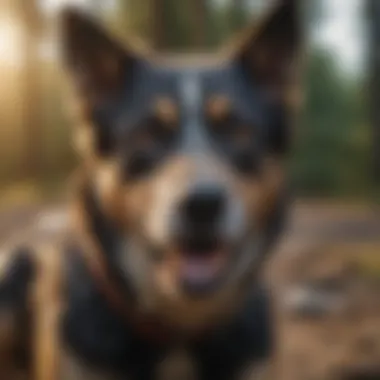Transforming Aggressive Dogs into Friendly Companions: A Comprehensive Guide


Pet Care Essentials
Pets are marvelous companions that bring immense joy to our lives as animal lovers. Ensuring their well-being is paramount, starting with meeting their daily nutrition requirements. It is crucial to provide a balanced diet rich in nutrients for optimal health. Daily meals should consist of high-quality protein, essential fats, carbohydrates, vitamins, and minerals. Adequate hydration is also vital; fresh water should be available at all times. Monitoring portion sizes according to your pet's size and activity level is important to prevent overeating or undernourishment.
Exercise and playtime are integral aspects of pet care essential for maintaining physical and mental health. Dogs, being naturally active beings, require regular exercise to expend energy and stimulate their minds. Engaging in interactive play sessions, brisk walks, or runs can help prevent behavioral issues caused by boredom or excess energy. Tailoring exercise routines to your pet's breed, age, and health condition is paramount for their well-being.
Regular grooming is not just about aesthetic appeal but is essential for maintaining your pet's overall health. Brushing your dog's coat regularly helps distribute natural oils, remove dirt and loose hair, and prevent matting. Nail trimming, ear cleaning, and dental care are also crucial aspects of grooming to ensure your pet remains healthy and happy.
Health and wellness check-ins are imperative to detect any potential issues early on and maintain your pet's optimal health. Regular visits to the veterinarian for check-ups, vaccinations, and preventive treatments are vital. Monitoring your pet's weight, appetite, behavior, and overall well-being at home allows you to promptly address any concerns and ensure they lead a long and healthy life.
Understanding Aggression in Dogs
Understanding Aggression in Dogs is a crucial aspect of transforming an aggressive dog into a friendly companion. By delving into the root causes of aggression, pet owners can gain valuable insights that contribute to creating a harmonious relationship with their furry friends. Recognizing the signs and triggers of aggression empowers owners to address problematic behavior effectively, fostering a positive environment for both the pet and the household. This section serves as a foundation for implementing strategies to modify behavior and encourage positive interactions.
Identifying Signs of Aggression
Growling and Baring Teeth
Growling and Baring Teeth are unmistakable indicators of an aggressive stance in dogs. This behavior showcases the canine's discomfort or sense of threat, requiring immediate attention from pet owners. Understanding the nuances of Growling and Baring Teeth allows owners to decipher their pet's emotional state accurately and respond accordingly. While intimidating, these signs provide crucial information that can guide owners in modifying their dog's behavior effectively, steering them towards friendlier interactions.
Snapping or Biting
Snapping or Biting is a serious manifestation of aggressive behavior that demands careful consideration. This action signifies a heightened level of stress or fear in the dog, prompting a defensive response. Addressing the underlying triggers behind Snapping or Biting is essential in creating a safe environment for both the dog and its caregivers. By dissecting the contexts in which these behaviors occur, pet owners can develop targeted interventions to mitigate aggression and promote healthier interactions.
Body Stiffness and Raised Fur
Body Stiffness and Raised Fur are physical manifestations of a dog's psychological state, portraying discomfort or agitation. Recognizing these bodily cues aids owners in preempting potential outbursts, averting potentially risky situations. While alarming, these signs offer valuable insights into the dog's emotional well-being, guiding informed decisions on managing aggression effectively.
Common Triggers for Aggressive Behavior
Fear or Anxiety
Fear or Anxiety serves as a prevalent trigger for aggressive behavior in dogs. Understanding the emotional turmoil that underlies these responses is crucial for developing compassionate interventions. By acknowledging and addressing the sources of fear or anxiety, pet owners can create a supportive environment that nurtures their pet's emotional resilience and diminishes aggressive tendencies.


Territorial Instincts
Territorial Instincts prompt dogs to assert dominance and protect their perceived domain. Exploring the roots of territorial behavior helps owners tailor their approach to modify this conduct positively. By establishing boundaries and reinforcing a sense of security, owners can alleviate the impulse for territorial aggression, fostering a more relaxed and friendly atmosphere for their pet.
Protectiveness Over Resources
Protectiveness Over Resources stems from a dog's instinct to safeguard its possessions. Managing this behavior involves implementing strategies that promote sharing and cooperation, diminishing the need for possessive actions. By reshaping the dog's perspective on resources, owners can cultivate a more generous and accommodating demeanor, reducing conflicts over possessions.
Seeking Professional Assistance
Consulting a Veterinarian
Consulting a Veterinarian is a pivotal step in addressing aggressive behavior in dogs. Veterinarians offer expertise in diagnosing underlying health issues that may contribute to aggression, ensuring a holistic approach to behavior modification. Collaborating with a veterinarian enables pet owners to uncover physical or mental ailments that could fuel aggression, laying the groundwork for effective treatment and behavioral adjustments.
Enlisting the Help of a Certified Dog Trainer
Enlisting the Help of a Certified Dog Trainer provides specialized guidance in addressing behavioral concerns. Certified trainers possess the knowledge and experience to design customized training programs that target specific problem behaviors. Working alongside a professional trainer equips pet owners with effective techniques and strategies to recondition their dog's responses, fostering positive behaviors and a harmonious bond.
Creating a Safe Environment
In this segment of the article, we delve into the pivotal aspect of creating a safe environment for your aggressive dog. Ensuring a secure setting is fundamental to the successful transformation of aggressive behavior into friendly interactions. By focusing on this key element, pet owners can significantly enhance the well-being and behavior of their beloved companions. Establishing a safe environment involves factors such as implementing positive reinforcement techniques, setting clear boundaries, and providing adequate physical and mental stimulation.
Implementing Positive Reinforcement Techniques
Reward-Based Training
Reward-Based Training is a cornerstone of fostering positive behavior in aggressive dogs. By rewarding desired actions with treats or praise, pet owners can effectively encourage friendly behavior while discouraging aggression. This method emphasizes reinforcing good behavior to shape a dog's responses to various stimuli. The distinct advantage of Reward-Based Training lies in its ability to create a strong bond between the dog and its owner through positive interactions.
Consistency in Commands
Consistency in Commands plays a vital role in cultivating obedience and predictability in an aggressive dog's behavior. By delivering commands in a consistent manner, pet owners establish a clear communication channel with their pets, leading to better comprehension and adherence to instructions. This element is crucial in maintaining structure and discipline within the training regimen, promoting a harmonious relationship based on trust and mutual understanding.
Use of Clicker Training
Utilizing Clicker Training offers a precise and versatile method to reinforce positive behaviors in aggressive dogs. The distinct sound of a clicker serves as a marker to signal desired actions, enabling quick and accurate feedback during training sessions. This technique enhances the dog's learning experience by associating the click with a reward, leading to accelerated progress and improved training outcomes.


Establishing Boundaries
Setting Clear Rules
Setting Clear Rules is essential in creating a consistent and structured environment for an aggressive dog. By establishing clear guidelines and expectations, pet owners provide their pets with a sense of security and understanding of acceptable behaviors. This practice reduces confusion and establishes a framework for positive interactions, ultimately fostering a respectful and cooperative relationship between the pet and its owner.
Designating Safe Spaces
Designating Safe Spaces offers a retreat for an aggressive dog to seek solace and calmness when feeling overwhelmed or agitated. By designating specific areas within the living space as safe zones, pet owners provide their dogs with a secure place to relax and recharge, promoting emotional well-being and stress relief. This practice empowers dogs to self-regulate their emotions and behavior in stressful situations.
Avoiding Triggers
Avoiding Triggers is crucial in preventing potentially aggressive responses in dogs with a history of aggression. Identifying and eliminating triggers that incite negative reactions in pets plays a significant role in managing and reducing aggressive behavior. By proactively avoiding triggers such as loud noises, unfamiliar individuals, or stressful environments, pet owners create a calmer and more controlled atmosphere for their dogs, promoting a sense of security and well-being.
Ensuring Physical and Mental Stimulation
Regular Exercise Regimen
Incorporating a Regular Exercise Regimen is essential for maintaining both the physical and mental well-being of an aggressive dog. Regular physical activity not only helps in burning off excess energy but also promotes cardiovascular health and muscle tone. Mental stimulation through activities such as interactive games and puzzle toys challenges the dog's cognitive abilities, preventing boredom and behavioral issues related to pent-up energy.
Engaging Toys and Puzzles
Engaging Toys and Puzzles are valuable tools in keeping an aggressive dog mentally engaged and entertained. Interactive toys and puzzles offer mental stimulation by encouraging problem-solving skills and strategic thinking. By providing a variety of toys that cater to different play styles, pet owners can keep their dogs mentally stimulated and prevent negative behaviors resulting from boredom or lack of mental challenges.
Interactive Playtime
Interactive Playtime fosters social interaction and bonding between pet owners and their aggressive dogs. Engaging in play sessions that involve physical activity and mental stimulation not only strengthens the emotional connection between the dog and its owner but also provides an outlet for releasing stress and tension. This quality time spent together enhances communication, trust, and mutual enjoyment, further solidifying the bond between the pet and its caregiver.
Building Trust and Strengthening the Bond
In the quest to understand and rectify aggressive behavior in dogs, a fundamental element that stands out is the concept of building trust and strengthening the bond between pet and owner. This pivotal aspect serves as the cornerstone for transforming the dynamics of the relationship and fostering a healthier environment for both parties involved. By establishing trust, pet owners lay a solid foundation for effective communication and mutual respect, essential components in addressing and mitigating aggression in dogs.
Patience and Consistency


Gradual Desensitization
Embarking on the journey of gradual desensitization with an aggressive dog is akin to navigating a delicate balance between progress and caution. This systematic approach involves exposing the dog to triggering stimuli in a controlled manner, gradually desensitizing them to once-provocative situations. The key characteristic of gradual desensitization lies in its strategic pacing, allowing the dog to acclimate to stressors at a manageable pace. This method, although time-intensive, proves beneficial in reprogramming the dog's responses and fostering resilience towards potential triggers.
Avoiding Punishment
Contrary to traditional methods of punishment, the approach of avoiding punishment emphasizes redirection and positive reinforcement as avenues for behavior modification. By steering clear of punitive measures, pet owners pivot towards creating a safe and encouraging environment for their dog to thrive. The essence of this method lies in replacing negative behaviors with positive alternatives, thereby nurturing trust and confidence within the human-canine relationship. While the process may demand patience and consistency, the long-term benefits of this approach far outweigh the temporary respite of punitive actions.
Building Positive Associations
At the crux of behavioral transformation lies the concept of building positive associations within the dog's cognitive framework. This strategy centers on linking pleasant experiences with previously negative triggers, reshaping the dog's perceptions and emotional responses. The core characteristic of this technique lies in its ability to rewire neural pathways, forging new connections that contribute to a calmer and more balanced demeanor. Though demanding a vigilant and dedicated effort, the rewards of instilling positive associations amplify the bond between dog and owner, laying the groundwork for sustainable behavioral changes.
Engaging in Socialization
Introducing to New Environments
Introducing an aggressive dog to novel environments presents a unique opportunity for growth and adaptation within the canine psyche. This strategic immersion exposes the dog to unfamiliar stimuli, encouraging flexibility and resilience in the face of change. The key characteristic of this process lies in its capacity to broaden the dog's social repertoire, enriching their behavioral responses and expanding their comfort zones. While the initial stages may pose challenges, the gradual acclimatization to new environments nurtures a sense of confidence and security in the dog's interactions.
Interacting with Other Dogs
The integration of social interactions with other dogs serves as a foundational pillar in fostering healthy socialization skills and behavioral cues. By engaging in controlled and supervised dog-to-dog interactions, aggressive dogs have the opportunity to refine their communication skills and establish hierarchies within social dynamics. The key characteristic of this interaction lies in its ability to teach dogs appropriate boundaries and enhance their ability to interpret canine body language effectively. Through consistent socialization practices, pet owners pave the way for improved social behaviors and harmonious engagements between their dog and peers.
Exposing to Different Stimuli
Exposure to diverse stimuli forms an integral part of a comprehensive socialization regimen for aggressive dogs, broadening their sensory experiences and enhancing adaptation skills. This deliberate exposure to various stimuli, such as different sounds, textures, and environments, enriches the dog's perceptual repertoire and fosters adaptability in unfamiliar contexts. The unique feature of this approach lies in its versatility, catering to individual dog personalities and temperaments to create a well-rounded socialization experience. While requiring tailored planning and supervision, the benefits of exposing dogs to different stimuli underscore the importance of promoting well-rounded social skills and emotional resilience.
Maintenance and continued Training About Injection
Developing a coherent and engaging narrative for this article involves a detailed discussion on the significance of Maintenance and Continued Training. This section encapsulates the crux of ensuring long-term behavioral changes in aggressive dogs. Maintenance and Continued Training ascertain the sustained progress and development of your furry companion, providing a structured framework to address underlying issues effectively. An essential component of the holistic approach outlined in this comprehensive guide, Maintenance and Continued Training highlight the ongoing commitment required from pet owners to instill lasting positive behaviors. Through consistent reinforcement and regular evaluation, pet owners can create a nurturing environment conducive to their dog's growth and well-being. Offering insights into best practices and potential challenges, this section serves as a pivotal guidepost in the journey towards transforming aggression into friendliness.
Regular Evaluation and Adaptation d
Approaching the theme of Regular Evaluation and Adaptation pointings at the core of sustained progress in training. The assessment aspect, elaborated under the Monitoring Progress domain, forms a critical foundation for gauging the effectiveness of implemented techniques. It involves closely tracking your dog's responses, identifying patterns, and adjusting strategies accordingly. Monitoring Progress aids in identifying early signs of improvement or setbacks, allowing pet owners to tailor their approach to suit their dog's unique needs. Emphasizing consistency and objectivity, this continual evaluation process plays a vital role in crafting tailored training regimens that align with the dog's progress and behavior. Moreover, this adaptive approach reinforces positive learning experiences and fosters a deeper understanding of the behavioral dynamics at play.
Juggling Enthusiastically Reinforcement
Consistency in Reinforcement stands as a cornerstone concept in the training journey with aggressive dogs. This pivotal section underscores the importance of establishing clear reinforcement techniques that are reliably applied. Ongoing Positive Reinforcement functions as a powerful tool in shaping desirable behaviors by rewarding good conduct consistently. Through reinforcement, pet owners communicate expectations effectively and reinforce positive interactions with their canine companions. Additionally, Reinforcing Good Behavior sheds light on the reinforcement of desirable actions through verbal praise, treats, or toys, encouraging a conducive environment for learning and growth. Addressing Setbacks Effectively naunces and redirects undesirable behaviors in a constructive manner, fostering resilience and adaptability in both the pet and owner relationship. This nuanced response to setbacks cultivates a sense of collaboration and understanding between the parties involved, paving the way for continued progress and development.
Celebrating Achievements Elatedly
Within the realm of Celebrating Achievements in dog training, a warm and encouraging atmosphere is cultivated to reinforce positive behaviors. Acknowledging Improvements serves as a reflective component that acknowledges incremental progress made by the dog, reinforcing their efforts towards learning and adapting. Building Trust Through Rewards engenders a sense of mutual trust and respect between the pet and owner, solidifying the bond and motivating further positive behavior. Moreover, Expressing Affection and Encouragement adds a layer of emotional support to the training process, nurturing a sense of security and camaraderie. By celebrating achievements, pet owners can amplify the impact of their training efforts, creating a rewarding and fulfilling experience for both themselves and their loyal companions.







